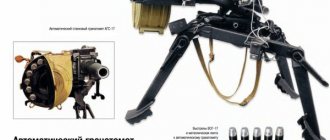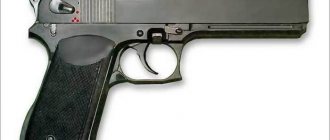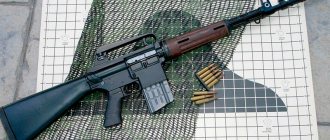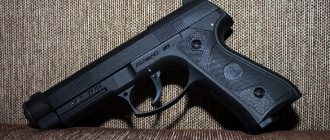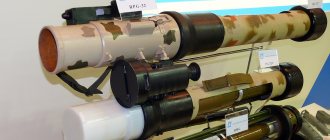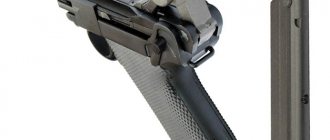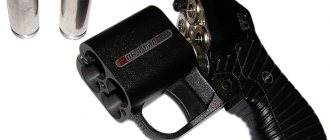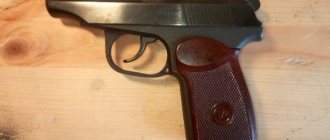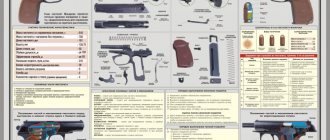TKB-205
Published by admin on Sun, 12/27/2009 – 01:57
TKB-205, 1940, Russia
Tactical and technical characteristics of TKB-205 Caliber, mm – 9 Barrel length, mm – 95 Length of the pistol when cocked, mm – 174 Height of the pistol, mm – 123 Width of the pistol along the casing, mm – 20 Length of the aiming line, mm – 140 Number of rifling in the trunk, pcs. – 6 Length of the rifled part of the barrel, mm – 74.4 Weight of the pistol with a magazine without cartridges, g – 735 Weight of the pistol with a loaded magazine, g – 821 Weight of the bolt, g – 251 Number of factory parts, pcs. – 23
Along with Tokarev and three other designers, M.V. Margolin participated in a competition to develop a new 7.62 mm army pistol to replace the TT. After some time, he withdrew from the participants on his own initiative, considering that the time had come to work on a design for the 9-mm cartridge.
Options and modifications of OTs-23
In addition to the original version of the pistol, its analogue was designed - OTs-23M. It was planned to be smaller in size and also to only hold 18 rounds of ammunition. In addition, a more comfortable and ergonomic angled handle was envisioned. However, there was no automatic firing mode.
K.V. Demidov worked on creating a cartridge specifically for this model. He created samples based on the cartridge case used in the PSM pistol. The bullet has high speed due to a high-quality steel core. The shape resembles something between “PSM” and 5.45x39. The ammunition also has a special annealed skirt for better penetration into cuts.
The starting speed of the ammunition was 600 meters per second.
The sample demonstrated high penetration capabilities and fast aiming. The recoil after the shot was minimal.
The downside of the development was that it did not have a stopping effect. They tried to compensate for this shortcoming with the ability to fire in bursts. However, this solution didn't work.
OTs-20 Gnome
Published by admin on Sun, 12/27/2009 – 01:04
OTs-20 Gnome, 1994, Russia
Tactical and technical characteristics of the OTs-20 Gnome Type – self-cocking hammer type USM – double action Caliber, mm – 12.5×40 Cartridge type – STs110, STs110-04, STs110-02 Overall dimensions, mm – 250x132x45 Weight without cartridges, kg – 1.1 Drum capacity, cartridge.
– 5 Target firing range, m – 25 Initial bullet speed: STs-110, m/s – 400 STs-110-04, m/s – 350 Bullet weight: STs-110, g – 11 STs-110-04, g – 12 The smoothbore revolver OTs – 20 “Gnome” is intended for arming the police and private security agencies with special statutory tasks. The revolver was developed by designers V.I. Seregin, A.N. Nevizhin and S.V. Zotov in 1994 at the Instrument Engineering Design Bureau. To fire from the OTs-20 “Gnome” revolver, special cartridges are used, collected in a shortened 32nd hunting caliber cartridge case.
OTs-21 Baby
Published by admin on Sat, 12/26/2009 – 19:16
OTs-21 Malysh, Russia
Tactical and technical characteristics of OTs-21 / OTs-21C Malysh Caliber, mm – 9×18 mm (9 x17 K) Overall dimensions, mm – 126x100x20 Barrel length, mm – 63.5 Weight with loaded magazine, kg – 0.56 Capacity store, patr. – 5 Effective firing range, m – 15–20 Initial speed of a rubber bullet, m/s – 315
The small-sized self-loading pistol OTs-21 “Malysh” was developed at TsKIB SOO by Yuri Ivanovich Berezin in the mid-90s. The designer used a 9-mm PM cartridge as ammunition - despite this, the dimensions of the OTs-21 are quite comparable to the 6.35 mm TK. In addition, the “Baby” has no protruding parts, and its width is only 2 centimeters.
5.45 mm submachine gun OTs-23 “Dart”
The crime situation that developed in Russia in the last decade of the last century necessitated the development of special weapons for law enforcement agencies. The army weapons in their arsenal did not always correspond to the tasks performed.
One of the first steps in this direction was the creation by the designer of TsNIITOCHMASH A. Denisova of the 5.45-mm pistol cartridge MPTs (small-caliber, pistol, central fire). The high qualities of this cartridge in terms of penetration of solid barriers and accuracy were confirmed on the PSM pistol (self-loading pistol, small-sized). The characteristics of the MPC cartridge turned out to be acceptable for creating a portable close-combat submachine gun. The first model of such a weapon, with the factory designation OTs-23 and the name “Dart”, for arming operatives of law enforcement agencies, was developed by the leading designer of the Tula TsKIB SOO I. Stechkin together with the designers of his group A. Baltser and A. Zinchenko. Considering that the stopping effect of 5.45 mm bullets of MPTs cartridges is inferior to the most common pistol bullets (for example, 7.62 mm bullets of a TT pistol, 9 mm bullets of a PM pistol and others), the OTs-23 uses a burst firing mode three shots with a rate of fire of 1,700 rounds per minute. This provides a very high stopping effect. The ballistic impulse of the MPTs cartridge is approximately 2.3 times less than that of the 9x17 PM pistol cartridge. This and the presence of a muzzle tilt compensator in the form of a hole in the barrel at the muzzle allow effective shooting with both hands without a shoulder rest. As a last resort, firing in fixed bursts and with one hand is allowed. Externally, the OTs-23 is a pistol, but in terms of its combat qualities it can be called a pocket submachine gun.
Work on the OTs-23 began in 1993 and was completed in 1996 with its adoption by the Ministry of Internal Affairs of the Russian Federation.
The OTs-23 automation is based on the principle of blowback, i.e. The barrel bore is locked due to the inertia of the bolt. The OTs-23 bolt, unlike many pistols, is not a barrel shroud, since it does not completely cover the barrel, leaving its upper part open. The total length of the barrel is 125 mm, but the length of the rifled part is 85 mm. The remainder of the barrel is made up of the chamber and muzzle compensator.
The specificity of the functioning of the OTs-23 bolt is that with a full rollback value of 47 mm, the bolt, not reaching the rearmost position by 5 mm, collides with the movable, massive barrel and rolls back together with it. Due to this interaction, the speed of impact of the bolt with the barrel on the weapon frame is reduced, which, in turn, reduces vibrations of the weapon and the dispersion of hits. This method was first proposed and applied by I. Stechkin on the OTs-23 and was later used on the OTs-27 “Berdysh” self-loading pistol and the OTs-33 “Pernach” automatic pistol.
The OTs-23 trigger mechanism is of the hammer type with an open trigger of the so-called “double” action, i.e. allowing firing both with a pre-cocked hammer and self-cocking.
To put the weapon on safety, release the hammer and select the firing mode - single fire or "triples" - there are rotary flags, for ease of use by both the right and left hands, symmetrically located on both sides of the bolt.
The cartridges are fed from a 24-round box magazine with a double-row arrangement and a double-row exit. The magazine is held in the weapon's handle by a latch, which can be operated from both the left and right sides of the weapon.
The sighting devices of the OTs-23 are the rear sight and the front sight, which are installed when the weapon is brought into normal combat at one fixed firing distance.
All parts of the gun are made of heat-treatable steel with the predominant use of milling operations.
Chemical phosphating was used as a protective anti-corrosion coating. This coating is inferior in decorative qualities to the oxide coating used, for example, on PM pistols and previously on APS automatic pistols, but has significantly higher anti-corrosion properties.
The weapon handle is covered on both sides with cheeks, held on the frame with one screw. The cheeks can be made of either plastic or valuable wood, such as walnut. Wooden cheeks are more difficult to manufacture than plastic ones, but are more comfortable when holding a weapon in your hand for a long time.
Main characteristics
- Caliber, mm………………………………………………………5.45
- Cartridge type………………………………….5.45×18 mm MPC
- Weight with empty magazine, kg……..0.96
- Magazine capacity, cartridges………………..24 Weapon dimensions, mm:
- length…………………………………………..195
- height………………………………………….223
- width……………………………………………………32
- Initial bullet speed, m/s………………330
- Rate of fire, rounds/min……………………1700 Firing modes:
- single and automatic fire
- fixed queues (“triples”)
Soldier of Fortune No. 7 2006
OTs-23 Dart
Published by admin on Sat, 12/26/2009 – 18:18
OTs-23 Dart / AP SBZ, Russia
Tactical and technical characteristics of OTs-23 Dart Caliber, mm – 5.45 (5.45x18 MPC) Overall dimensions, mm – 195x135x32 Barrel length, mm – 127 Weight without cartridges, g – 865 Weight of equipped weapon, kg – 0.96 Temp firing, v/m – 1700 Rate of fire, v/m – 30–50 Magazine capacity, cartridge. – 24 Target firing range, m – 50 Initial bullet speed, m/s – 325
The Dartik OTs-23 pistol or AP SBZ (Stechkin, Baltzer, Zinchenko automatic pistol) was developed by the Tula KBP. It is a personal weapon of attack and defense. The automatic operation of the pistol operates due to the recoil of the free bolt. The impact mechanism is trigger, with its open arrangement. The trigger mechanism allows firing by self-cocking and with pre-cocking. The return spring is located under the barrel. The trigger guard has a finger rest, making it easy to shoot with both hands.
Pistol OTs-23 Dart - don’t you dare bury it!
Lately, articles have mainly been about foreign weapons; it’s time to restore the balance and take on domestic models. And perhaps it’s worth starting with the “Dart” pistol, which was developed by the designers Stechkin, Baltser and Zinchenko, especially since they asked to make an article about this weapon in the comments under the material about the Five-seveN pistol. It must be said right away that the weapon is very rare, was produced in very small quantities and was not widely used due to the low-power cartridge used in this pistol. Nevertheless, the sample is very interesting, has its own unique features and is quite suitable for being “reanimated” in our time, of course, adapted for more effective ammunition. But first things first, let’s start, as usual, with the ammunition for this weapon, since the 5.45x18 MPC cartridge is not nearly as well known as the others.
Perhaps the most important feature of the 5.45x18 cartridge is that it was developed by a woman. Don’t think, I have nothing against women’s participation in the arms business, but usually this is rare. However, in the early 70s, Antonina Dmitrievna Denisova began work on creating a small-caliber pistol cartridge that could compete with 9x17 and 9x18 in its characteristics, but would be smaller, have less recoil when firing and have greater armor-piercing power. The main idea of the designer was that if the bullet is of sufficient length and its balance is incorrect, even with a small caliber it will completely transfer its energy to the enemy’s body. In addition, it was assumed that the design of the bullet would promote the expansion of the Kevlar fibers in the body armor, rather than tearing them, which would provide better armor-piercing qualities of this ammunition. In addition, the bullet core had to provide a high ability to penetrate armor. In theory, everything looked great, and in practice everything was partially confirmed. Everything except stopping action. Don’t throw tomatoes at me here, in terms of armor-piercing power - the 5.45x18 cartridge really surpasses the standard cartridge of the Makarov pistol, so we can talk about achieving the desired result.
As a result of the work of Antonina Dmitrievna Denisova, a cartridge weighing 10.2 grams was born, well known to everyone from the small-sized PSM pistol. There are two variants of the cartridge with a bullet weighing 2.4 grams and a bullet weighing 2.6 grams, while the initial speed of both variants of bullets when used in the PSM pistol is equal to 325 meters per second, respectively, the kinetic energy of these projectiles is equal to the ridiculous values of 119 and 129 Joules. The design of the bullet is interesting. There is a steel core in its nose, followed by lead to increase the weight of the bullet. Thus, it turns out that the center of gravity of such a bullet is shifted back, which is not good, especially given that the designer expected to increase the lethality of the bullet due to its length. However, we are talking about a pistol cartridge, so there is nothing wrong with that. On the contrary, such balancing of the bullet promotes somersault in the enemy’s body, and this is just very good, not for the enemy, of course. Since there was a steel core in the front of the bullet, another problem arose in the form of ricochets. To get rid of it, the nose of the bullet had to be truncated, which partially deprived the projectile of its ricocheting ability, but had a negative impact on its armor-piercing ability. It was this kind of ammunition that it was decided to use in the new pistol.
In the early 90s of the last century, the domestic arms industry persistently promoted a not very successful idea for combating personal armor protection in the form of bullets hitting one point. Of course, this was impossible to do, however, even if they hit close, theoretically, the bullets would hit the enemy for sure. The main idea was that the first bullet should have destroyed the personal protective equipment, and the second should have hit the enemy along a cleared path. The designers who took on the creation of the OTs-23 pistol had a slightly different view on the use of this phenomenon. So, instead of armor-piercing, the main emphasis was placed on the fact that when bullets hit next to each other, their stopping effect could be summed up, which means it was possible to create a weapon with low recoil, but with very high efficiency. Well, armor-piercing, of course, was not superfluous, but in practice the theory worked every other time, or even three.
This is how the initial vision of such a weapon as a pistol with the ability to fire automatically and cut off with small-caliber bullets was created. At the first glance at the weapon, it becomes clear that the APS is a relative of this pistol, albeit a distant one; there are a lot of similar features in the appearance of the weapon, but it is not the appearance that makes the pistol beautiful. A much more interesting point was the implementation of the pistol’s automatic operation, with very low recoil, but with very high combat potential. Despite the fact that the weapon has a rather serious appearance and weight, even a child can shoot from it, and shoot with automatic fire, without a butt and with one hand. First of all, you need to note the cutout in the barrel, which plays the role of a recoil compensator and does not allow the barrel of the weapon to ride up when firing. But this solves only one problem, since the movement of the rather massive bolt casing clearly did not have the most positive effect on the accuracy of the weapon, especially taking into account the rate of fire of 1800 rounds per minute. It was this problem that Stechkin solved, and he solved it ingeniously simply.
The automatic operation of the pistol is based on a blowback mechanism, but something in this simple mechanism has been modified. When fired, powder gases tend to push the bullet out of the barrel and the cartridge case out of the chamber. The ejection of the cartridge case is prevented only by the bolt, which is spring-loaded by a return spring. As a result of this, after the bullet has left the barrel of the pistol, the bolt retains the energy received from the cartridge case and moves back. As the bolt casing moves backward, the spent cartridge case is removed and thrown outside the pistol structure. And this is where miracles begin. The bolt engages with the barrel and then moves with it, as a result of which the casing-bolt-barrel group sharply loses speed due to the increased moving total mass. After reaching its extreme position, under the action of the return spring, everything returns to its place, simultaneously picking up a new cartridge from the magazine. It is precisely such decisions that make domestic gunsmiths proud.
The pistol itself turned out to be relatively heavy - 850 grams excluding cartridges. The magazine holds 24 cartridges, that is, the weight of the ready-to-use weapon is slightly less than 1.1 kilograms. The length of the pistol is 195 millimeters with a barrel length of 125 millimeters. On the right and left sides of the weapon, on the bolt housing there is a safety/fire mode switch. Automatic fire is carried out with a cut-off of 3 rounds, that is, all 24 rounds are fired in 8 short bursts.
Unfortunately, I was not able to get acquainted with the weapon in person; I only had the opportunity to see how another person handled it. And you know, I was impressed. What was especially impressive was that three shots merge into one, and at the same time the weapon itself remains practically motionless in the shooter’s hands. The pistol has not become widespread, as noted earlier, the reason for this is only in the cartridge, which does not reach the super characteristics even in such a perfect weapon, and even in combination with two more cartridges. But, in my opinion, not to continue the further development of this weapon would be simply a crime. After all, there are sub-caliber bullets, there is foreign experience with similar ammunition, there are examples of use, and very good ones. In general, I really hope that this sample was not completely buried, and that somewhere people are still resuscitating it.
APS
Published by admin on Mon, 12/21/2009 – 01:35
Automatic Pistol Stechkin / APS, 1951, Russia
Tactical and technical characteristics of APS Caliber, mm – 9×18 mm PM Length, mm – 225 Barrel length, mm – 140 Length, mm: without holster-stock – 225 with holster-stock – 540 Height, mm: – 150 Weight, kg : without cartridges and holster-stock – 1.02 equipped without holster-stock – 1.22 holster-stock – 0.56 Rate of fire, rounds per minute – 600 Magazine capacity – 20 Muzzle energy, J – 338-353 Effective firing range is: when firing single shots with an attached holster-butt, m - 150 when firing in bursts with an attached holster-butt, m - 100 when firing single shots without a holster-butt, m - 50
The history of the creation of one of the most popular and famous pistol-carbines of the USSR APS is connected with a curiosity. Then still a young student of the Tula Mechanical Institute, I. Ya. Stechkin defended his graduation project. The theme of the project was a short-barreled personal weapon of Soviet army officers that fired a burst. The topic was quite unusual and therefore the examiners were skeptical about the topic of the project from the very beginning.
- « first
- ‹ previous
- …
- 9
- next ›
- last »
